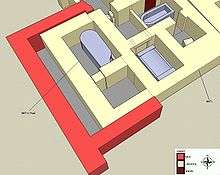Pami
| Pami | |
|---|---|
 Year 2 Apis stela from Pami's reign found in Saqqara. Louvre | |
| Pharaoh | |
| Reign | 785 – 778 BC (22nd Dynasty) |
| Predecessor | Shoshenq IV |
| Successor | Shoshenq V |
|
| |
Usermaatre Setepenre Pami was an ancient Egyptian pharaoh of the 22nd Dynasty who ruled for 7 years. "Pami" in Egyptian, means "the Cat" or "He who belongs to the Cat [Bastet]."[2]
Identity
Pami's precise relationship with his immediate predecessor—Hedjkheperre Setepenre Shoshenq IV—is unknown but he is attested as the father of Shoshenq V in a Year 11 Serapeum stela dating to the latter's reign. Pami was once assumed to be Pimay, the third son of Shoshenq III who served as the "Great Chief of Ma" under his father. However, the different orthographies of their names (Pami vs. Pimay) prove that they were 2 different individuals. In addition, the name Pami translates as 'The Cat' in Egyptian whereas the name Pimay means 'The Lion.' Pami's name was mistakenly transcribed as Pimay by past historians based upon the common belief that he was Shoshenq III's son. This is now recognised to be an erroneous translation of this king's nomen/name which should rather be written as Pami. While a previous Dynasty 22 king held the title 'Great Chief of the Ma' before ascending the throne–namely Shoshenq I–Shoshenq III's son, Pimay, was a different man from king Pami because their names are different. Moreover, if Pimay did indeed outlive his father, he should have then succeeded his father as king rather than the obscure Shoshenq IV who is not attested as a son of Shoshenq III. Consequently, it seems certain that Shoshenq III outlived all of his sons through his nearly 4 decade long reign.
While a minority of scholars hold to the traditional view that Pami was Pimay, a son of Shoshenq III by his wife Queen Djed-Bast-Es-Ankh, no archaeological evidence proves that Pami was ever a son of Shoshenq III. The different spelling and meanings of the word Pami and Pimay and the fact that Shoshenq III was actually succeeded by Shoshenq IV—rather than Pimay as was once thought—suggest rather that Pami was a son of his obscure predecessor--Shoshenq IV instead.
Reign Length

Two Apis bulls were buried in Pami's own reign—one each during his Second and Sixth Year respectively. The Year 2 II Peret day 1 Serapeum stela from Pami's reign states that 26 Years passed between Year 28 of Shoshenq III–the burial of the previous Apis Bull—and Year 2 of Pami. Pami's Highest Year Date was originally thought to be his 6th Year based on his Year 6 Serapeum stela. However, in 1998, Pierre Tallet, Susanne Bickel and Marc Gabolde from the University of Montpellier published[3] the surviving contents of a reused stone block from an enclosure wall at Heliopolis. According to the article, the block is 2 cubits (104 cm) large and likely formed the right inside side of a doorway. The block is essentially an Annal document which postdates Pami's reign and was originally part of a larger monument which catalogued the deeds of various Dynasty 22 Pharaohs. However, only the section concerning Pami's reign has survived. It chronicles this king's Yearly donations both to the gods of the Great Temple of Heliopolis and to other local deities and temples in this city. While the ending of the block is damaged, a 7th Regnal Year can be clearly seen for Pami and a brief 8th Year in the lost or erased section is possible. In any event, his Highest Year Date is now his 7th Year and Pami would have reigned for almost 7 full years based upon this document.
References
| Wikimedia Commons has media related to Pami. |
- ↑ Jürgen von Beckerath, Handbuch der ägyptischen Königsnamen (= Münchner ägyptologische Studien, vol 46), Mainz am Rhein: Verlag Philipp von Zabern, 1999. ISBN 3-8053-2310-7, pp.190-91.
- ↑ Peter Clayton, Chronicle of the Pharaohs, Thames & Hudson Ltd, (1994), p.185
- ↑ Tallet, P., Bickel, S. & Gabolde, M. (1998), "Des annales héliopolitanes de la Troisième pèriode intermédiaire", BIFAO 98: 31-56